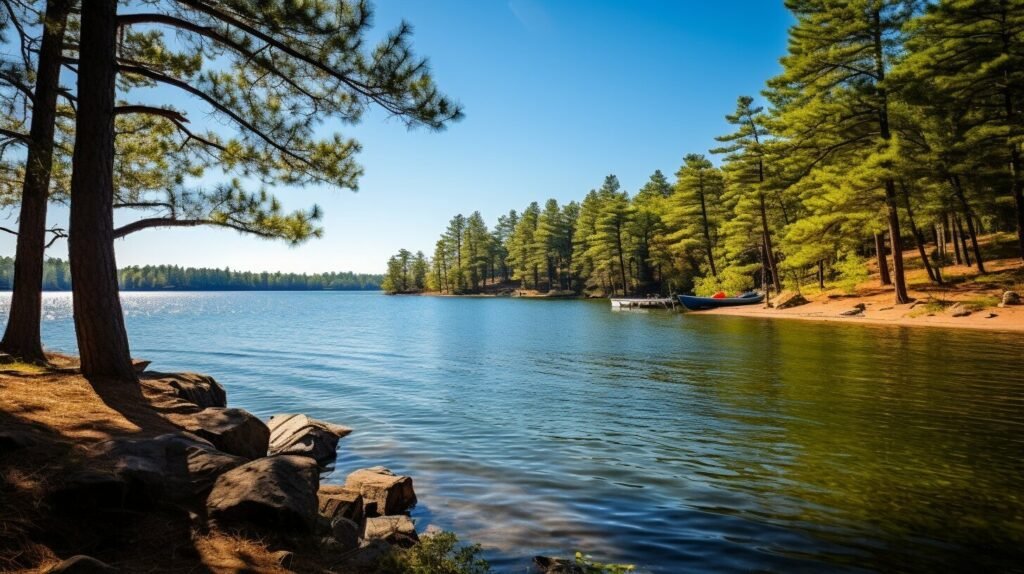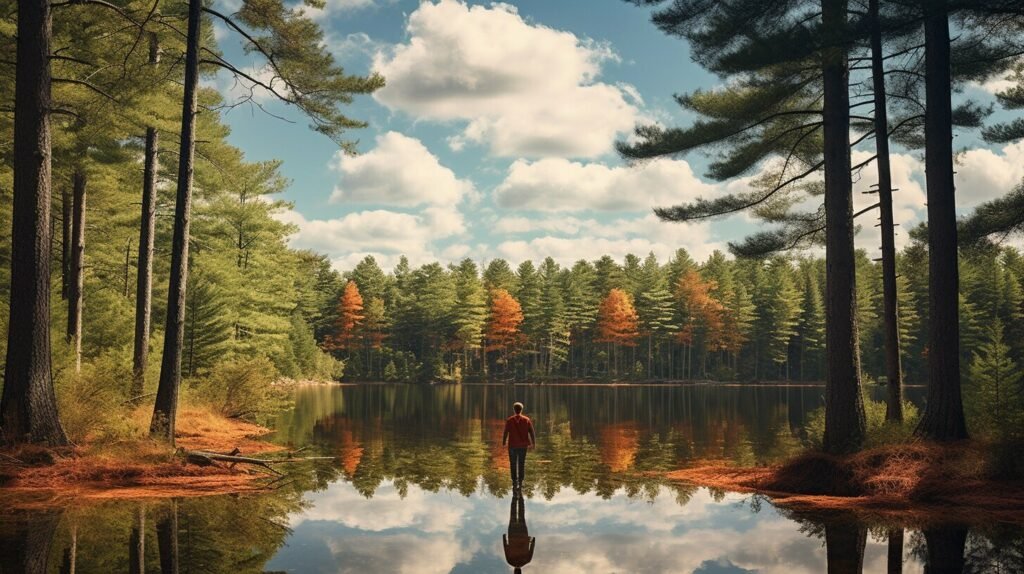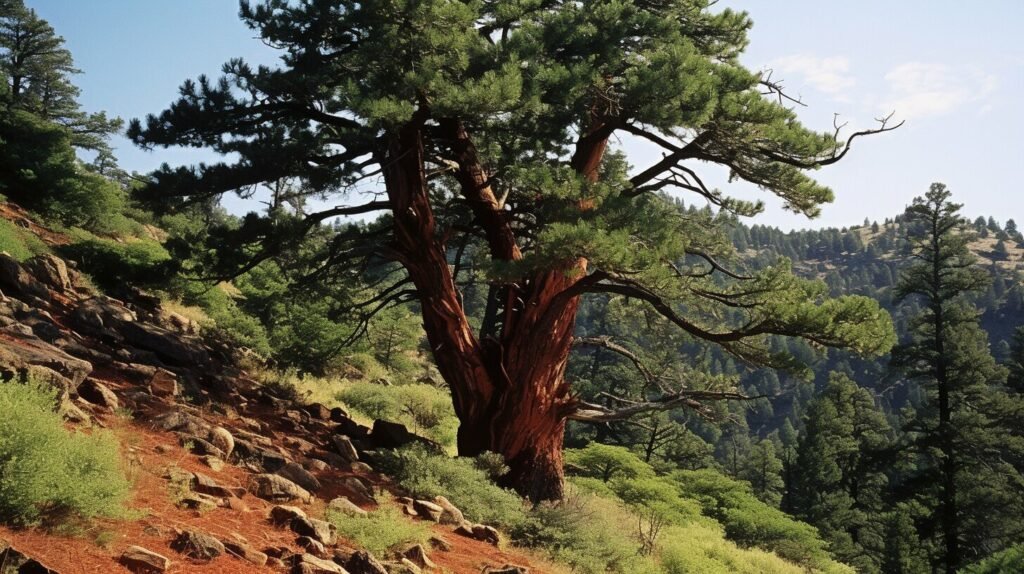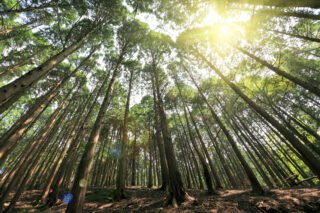Table of Contents
- The History and Designation of the Red Pine as Minnesota’s State Tree
- Characteristics and Appearance of the Red Pine
- Native Habitat and Natural Resources of the Red Pine
- Uses and Applications of the Red Pine
- Challenges and Conservation of the Red Pine
- Interesting Facts and Trivia about the Red Pine
- Conclusion: The Majesty of the Red Pine
- FAQ
- Q: What is the Red Pine’s scientific name?
- Q: How tall can the Red Pine grow?
- Q: What color is the Red Pine’s bark?
- Q: How do the needles of the Red Pine grow?
- Q: What color are the Red Pine’s needles?
- Q: How long are the Red Pine’s cones?
- Q: What is the Red Pine commonly used for?
- Q: What type of soil does the Red Pine prefer?
- Q: Where is the Red Pine native to?
- Q: What does the Red Pine provide for wildlife?
- Q: What challenges does the Red Pine face?
- Source Links
The Red Pine, also known as the Norway Pine, holds a special place in Minnesota as the state tree. This majestic conifer stands tall, reaching heights of over 125 feet, and its reddish-brown bark matures into distinctive large plates. With clusters of dark green needles that remain vibrant year-round, the Red Pine adds a touch of natural beauty to Minnesota’s landscape.
Key Takeaways:
- The Red Pine is the official state tree of Minnesota.
- Its reddish-brown bark and dark green needles make it visually striking.
- Red Pine is commonly used for timber and is important for forest ecosystems.
- It prefers nutrient-poor, sandy soil and full sun exposure.
- The tree is native to the northeastern United States and can be found in Minnesota.
As we delve deeper into this iconic tree, we will explore its historical significance, unique characteristics, native habitat, uses, and conservation efforts. Join me in discovering the magnificence of the Red Pine and its contribution to the natural wealth of Minnesota.
The History and Designation of the Red Pine as Minnesota’s State Tree
The Red Pine was officially designated as the state tree of Minnesota in 1953, through legislation backed by the Minnesota Federation of Women’s Clubs. This significant recognition highlights the importance of the Red Pine in the state’s natural heritage. The Minnesota Federation of Women’s Clubs played a crucial role in advocating for this designation, recognizing the tree’s beauty, cultural significance, and ecological importance.
The designation of the Red Pine as Minnesota’s state tree is enshrined in the Minnesota Statutes, solidifying its official status. This legislation formally recognizes the Red Pine as a symbol of the state’s identity, history, and natural wealth. Since the enactment of this statute, the Red Pine has become an icon of Minnesota’s landscape, capturing the imagination of residents and visitors alike.
The Red Pine’s designation as the official state tree reflects the deep appreciation that Minnesotans have for their natural surroundings. It represents the state’s commitment to preserving and celebrating its unique flora and fauna. The Red Pine stands as a testament to the beauty and resilience of Minnesota’s forests, serving as a reminder of the importance of conservation and sustainable management.
Characteristics and Appearance of the Red Pine
The Red Pine is a tall conifer that can reach heights of over 125 feet, making it an impressive presence in Minnesota’s forests. Its majestic stature and distinct features set it apart from other tree species. The bark of the Red Pine is reddish-brown and matures into large plates, adding to its visual appeal.
The needles of the Red Pine grow in clusters of two and remain dark green year-round, providing a splash of color amidst the winter landscape. This evergreen characteristic adds to the beauty of Minnesota’s forests throughout the year. Additionally, the Red Pine produces cones that are about 2 inches long, further showcasing its unique attributes.
The trunk of the Red Pine is straight and relatively free of branches, contributing to its impressive height. This characteristic makes it a valuable timber resource and plays a crucial role in the forestry industry. Its timber is known for its strength and durability, making it ideal for construction, furniture, and other applications.
Distinctive Features of the Red Pine:
- Tall conifer reaching heights over 125 feet
- Reddish-brown bark maturing into large plates
- Dark green needles growing in clusters of two
- Cones approximately 2 inches long
- Straight trunk with minimal branching
The Red Pine’s distinctive characteristics and striking appearance make it a beloved symbol of Minnesota’s natural beauty. Its towering presence in the state’s forests and its contribution to the economy and ecosystem highlight its importance and significance.

Native Habitat and Natural Resources of the Red Pine
The Red Pine, native to the northeastern United States, can be found in abundance within Minnesota’s state parks, providing valuable natural resources. This majestic tree species thrives in Minnesota’s sandy, nutrient-poor soil and prefers full sun exposure. Its ability to adapt to these conditions makes it an integral part of the state’s forest ecosystems.
Minnesota’s state parks are home to extensive Red Pine forests, which not only contribute to the natural beauty of the landscape but also serve as a vital resource for the state. The timber harvested from these forests is highly prized for its strength and durability, making it ideal for various construction and woodworking projects. Additionally, Red Pine forests provide nesting sites, shelter, and habitat for a diverse range of wildlife, contributing to the overall biodiversity and ecological balance of the region.

The Role in Forest Ecosystems
The Red Pine plays a crucial role in maintaining the health and stability of Minnesota’s forest ecosystems. As a pioneer species, it has the ability to quickly populate disturbed areas, helping to prevent soil erosion and facilitating the growth of other plant species. Its dense canopy provides shade and moisture regulation, creating a favorable environment for understory plants and protecting the forest floor from excessive sunlight and temperature fluctuations. Furthermore, the fallen needles of the Red Pine decompose slowly, enriching the soil with organic matter, and supporting the growth of other plants and fungi.
However, the Red Pine faces challenges in the form of insect and disease problems, particularly in warm climates. Insect pests like the Red Pine Sawfly and the Red Pine Scale can cause significant damage to the tree’s foliage and overall health. Additionally, diseases such as red pine needle cast and blister rust can impact the vitality of Red Pine populations. Efforts are being made to monitor and manage these threats to ensure the long-term conservation of this iconic tree species and its important role in Minnesota’s natural heritage.
Uses and Applications of the Red Pine
The Red Pine is commonly used for timber and plays a crucial role in providing nesting sites, shelter, and habitat for a wide range of wildlife species. Its straight and sturdy trunk makes it an ideal choice for timber production. The wood of the Red Pine is highly valued for its strength and durability, making it suitable for a variety of construction purposes, including furniture, flooring, and cabinetry. Its beautiful grain patterns and warm reddish color add to its appeal in the woodworking industry.
Furthermore, the Red Pine serves as a vital resource for wildlife. Its dense foliage and tall stature provide excellent nesting sites for birds such as the Bald Eagle and Osprey. Small mammals such as squirrels and chipmunks utilize its branches and trunk for shelter and protection. The tree also attracts a wide array of insect species, which in turn serve as a food source for birds and other wildlife.

In addition to its timber and wildlife benefits, the Red Pine enhances the overall biodiversity of forest ecosystems. Its extensive root system helps stabilize soil, preventing erosion and protecting water quality. The tree’s ability to thrive in nutrient-poor, sandy soil makes it a valuable species for reforestation efforts and ecological restoration projects.
Overall, the Red Pine’s uses and applications extend far beyond its aesthetic appeal. From timber production to providing nesting sites and shelter, this iconic tree species continues to contribute to the ecological and economic wealth of Minnesota.
Challenges and Conservation of the Red Pine
The Red Pine is susceptible to various insect and disease problems, which pose challenges to its health and conservation, especially in warmer climates. One of the most significant threats to the Red Pine is the invasive species, the European Pine Sawfly. These insects feed on the needles of the Red Pine, causing defoliation and weakening the tree’s overall health. Other pests, such as the Red Pine Needle Scale and the White Pine Weevil, also pose risks to the tree’s well-being.
In addition to insect infestations, disease problems further endanger the Red Pine. The most notable disease affecting this species is the Red Pine Blister Rust, caused by a fungus called Cronartium ribicola. This disease can lead to the death of infected trees and has had severe impacts on Red Pine populations across North America. Efforts are being made to develop resistant strains of Red Pine and implement disease management strategies to mitigate the spread of Red Pine Blister Rust.
The conservation of the Red Pine is crucial to protect its ecological importance and preserve its beauty for future generations. Conservation efforts include monitoring and controlling the spread of invasive pests and diseases, promoting sustainable forestry practices, and restoring and maintaining Red Pine habitats. Collaboration between government agencies, forestry experts, and conservation organizations is essential in effectively addressing these challenges and ensuring the long-term survival of this iconic tree species.
Conservation Strategies:
- Implementing pest management programs to control and prevent insect infestations.
- Developing and promoting disease-resistant strains of Red Pine.
- Engaging in reforestation initiatives to restore and expand Red Pine populations.
- Educating the public about the importance of Red Pine conservation and the role they can play in supporting these efforts.
- Establishing protected areas and conserving existing Red Pine habitats to preserve biodiversity and ecosystem integrity.

Despite the challenges it faces, the Red Pine remains an integral part of Minnesota’s natural heritage. Its majestic stature, ecological significance, and economic value make it a tree worth protecting. By working together to address the threats that it encounters, we can ensure the continued survival and prosperity of this remarkable state tree.
Interesting Facts and Trivia about the Red Pine
Did you know that the Red Pine, also known as the Norway Pine, has fascinating connections to Itasca State Park, the Minnesota Department of Natural Resources (DNR), and even the Secretary of State? Let’s explore some interesting facts and trivia about this iconic tree species.

- Itasca State Park: The Red Pine holds a special place in Itasca State Park, located in northern Minnesota. This park is home to the headwaters of the mighty Mississippi River, and abundant groves of Red Pine can be found throughout its scenic landscape. The majestic presence of these towering trees adds to the park’s natural beauty and attracts visitors from near and far.
- Minnesota DNR Recognition: The Minnesota Department of Natural Resources (DNR) acknowledges the significance of the Red Pine as the state tree. This recognition highlights the ecological importance and cultural significance of this tree species in Minnesota. The DNR actively promotes the conservation and sustainable management of Red Pine forests to preserve their beauty and benefits for future generations.
- Secretary of State Connection: The Red Pine has even captured the attention of the Minnesota Secretary of State. The Secretary’s office recognizes the importance of this iconic tree and its contribution to the state’s natural wealth. Its designation as the state tree signifies the Red Pine’s significance as a symbol of Minnesota’s rich natural heritage.
These interesting facts and associations demonstrate the deep-rooted connection between the Red Pine and Minnesota’s natural landscapes, government institutions, and cultural identity. As you explore the wonders of the Red Pine, take a moment to appreciate its historical, ecological, and symbolic importance to the Land of 10,000 Lakes.
Conclusion: The Majesty of the Red Pine
The Red Pine, as the state tree of Minnesota, symbolizes the wealth and natural splendor of the state, standing tall with its sturdiness and majesty. This towering conifer, also known as the Norway Pine, is a true symbol of Minnesota’s natural heritage.
Reaching heights of over 125 feet, the Red Pine commands attention with its reddish-brown bark that matures into large plates, adding to its distinctive allure. Its dark green needles grow in clusters of two, a constant reminder of the beauty that remains throughout the changing seasons. The tree’s cones, about 2 inches long, further enhance its visual appeal.
Not only does the Red Pine contribute to Minnesota’s aesthetic charm, but it also plays a crucial role in the state’s economic and ecological wealth. This tree species thrives in nutrient-poor, sandy soil, making it a valuable resource for timber production. Its wood is used in construction and furniture industries, providing economic benefits and employment opportunities.
Furthermore, the Red Pine serves as a vital component of forest ecosystems across Minnesota. It is native to the northeastern United States and can be found in Minnesota’s state parks, contributing to the natural wealth and diversity of these protected areas. The tree offers nesting sites, shelter, and habitat for a variety of wildlife, making it an important player in maintaining ecological balance.
However, the majestic Red Pine faces challenges in its survival. Insects and diseases pose significant threats, especially in warmer climates. Efforts are being made to conserve and manage this iconic tree species, safeguarding its presence for future generations.
In conclusion, the Red Pine stands as a testament to Minnesota’s wealth and natural beauty. As the state tree, it embodies the spirit of the land, its resilience, and its grandeur. Let us cherish and protect this majestic tree, ensuring its legacy continues to grace the landscape, enriching the lives of all who encounter it.
FAQ
Q: What is the Red Pine’s scientific name?
A: The scientific name of the Red Pine is Pinus resinosa.
Q: How tall can the Red Pine grow?
A: The Red Pine can reach heights of over 125 feet.
Q: What color is the Red Pine’s bark?
A: The bark of the Red Pine is reddish-brown.
Q: How do the needles of the Red Pine grow?
A: The Red Pine’s needles grow in clusters of two.
Q: What color are the Red Pine’s needles?
A: The Red Pine’s needles are dark green year-round.
Q: How long are the Red Pine’s cones?
A: The Red Pine’s cones are about 2 inches long.
Q: What is the Red Pine commonly used for?
A: The Red Pine is commonly used for timber.
Q: What type of soil does the Red Pine prefer?
A: The Red Pine grows well in nutrient-poor, sandy soil.
Q: Where is the Red Pine native to?
A: The Red Pine is native to the northeastern United States and can be found in Minnesota.
Q: What does the Red Pine provide for wildlife?
A: The Red Pine provides nesting sites, shelter, and habitat for wildlife.
Q: What challenges does the Red Pine face?
A: The Red Pine is susceptible to various insect and disease problems, particularly in warm climates.







